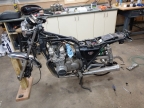Brought her home...
- old_kaw
-

- Offline
- User
-

Registered
- Posts: 929
- Thanks: 270
Re: Brought her home...
01 Jul 2019 13:31 - 01 Jul 2019 13:40
Rotisserie? I'm curious how well this works out for you. As I stated in other posts, I sealed up my tank with block off plates, then did the dryer tumble with it packed in tight. (~30 minutes, then reversed) First I did the tumble several times with MEK to remove the kreme crap and stop my carbs from plugging / flooding. Then I did the tumble with metal rescue and drywall screws to remove the trapped iron oxide. I now have a perfectly clean metal tank on a bike that never misses a beat. :whistle:
I'm sure everyone is sick of posting this pic of the block off plates, but this is how it's done.
It cleaned up nicely.
I'm sure everyone is sick of posting this pic of the block off plates, but this is how it's done.
Attachment not found
It cleaned up nicely.
Attachment not found
1981 Kawasaki Kz1000K1
Located in the Saint Louis, Missouri Area.
Located in the Saint Louis, Missouri Area.
Last edit: 01 Jul 2019 13:40 by old_kaw. Reason: proofreading is a good thing. :-)
The following user(s) said Thank You: SWest, Webbie1
Please Log in or Create an account to join the conversation.
- Webbie1
-
Topic Author
- Offline
- User
-

Registered
- Posts: 120
- Thanks: 16
Re: Brought her home...
01 Jul 2019 15:59old_kaw wrote: Rotisserie? I'm curious how well this works out for you. As I stated in other posts, I sealed up my tank with block off plates, then did the dryer tumble with it packed in tight. (~30 minutes, then reversed) First I did the tumble several times with MEK to remove the kreme crap and stop my carbs from plugging / flooding. Then I did the tumble with metal rescue and drywall screws to remove the trapped iron oxide. I now have a perfectly clean metal tank on a bike that never misses a beat. :whistle:
I'm sure everyone is sick of posting this pic of the block off plates, but this is how it's done.
Attachment not found
It cleaned up nicely.
Attachment not found
Gorgeous. Couple questions....Why drywall screws? And do you have the block off plates still?
Thanks,
Warner
1979 KZ1000 LTD, 1982 KZ1000 LTD, 1990 Honda CBR1000F
Please Log in or Create an account to join the conversation.
- Scirocco
-

- Offline
- Premium Member
-

Registered
- Never change a running system
- Posts: 4398
- Thanks: 2260
Re: Brought her home...
01 Jul 2019 16:09
Why drywall screws?
Drywall screws has sharp edges that cut into the rust layer.
Drywall screws has sharp edges that cut into the rust layer.
My 1975 Z 1 B 900 Project
www.kzrider.com/forum/11-projects/605133...ears-deep-sleep-mode
www.kzrider.com/forum/11-projects/605133...ears-deep-sleep-mode
Please Log in or Create an account to join the conversation.
- Webbie1
-
Topic Author
- Offline
- User
-

Registered
- Posts: 120
- Thanks: 16
Re: Brought her home...
01 Jul 2019 16:13old_kaw wrote: Rotisserie? I'm curious how well this works out for you. As I stated in other posts, I sealed up my tank with block off plates, then did the dryer tumble with it packed in tight. (~30 minutes, then reversed) First I did the tumble several times with MEK to remove the kreme crap and stop my carbs from plugging / flooding. Then I did the tumble with metal rescue and drywall screws to remove the trapped iron oxide. I now have a perfectly clean metal tank on a bike that never misses a beat. :whistle:
I'm sure everyone is sick of posting this pic of the block off plates, but this is how it's done.
Attachment not found
It cleaned up nicely.
Attachment not found
Looking at my tank, do you think a complete stripping of the paint is in order? I have a media blast cabinet that I just put together. Haven't even bought media for it yet.
Warner
1979 KZ1000 LTD, 1982 KZ1000 LTD, 1990 Honda CBR1000F
Please Log in or Create an account to join the conversation.
- Webbie1
-
Topic Author
- Offline
- User
-

Registered
- Posts: 120
- Thanks: 16
Re: Brought her home...
01 Jul 2019 19:33
My compressor and media blasting cabinet that I have yet to try. I did most of the mods to the cabinet that many suggest.
Warner
Warner
1979 KZ1000 LTD, 1982 KZ1000 LTD, 1990 Honda CBR1000F
Please Log in or Create an account to join the conversation.
- Webbie1
-
Topic Author
- Offline
- User
-

Registered
- Posts: 120
- Thanks: 16
Re: Brought her home...
01 Jul 2019 19:36Scirocco wrote: Why drywall screws?
Drywall screws has sharp edges that cut into the rust layer.
I've heard of using BB's, but never drywall screws. Definitely sound scratchy, though .
Warner
1979 KZ1000 LTD, 1982 KZ1000 LTD, 1990 Honda CBR1000F
Please Log in or Create an account to join the conversation.
- old_kaw
-

- Offline
- User
-

Registered
- Posts: 929
- Thanks: 270
Re: Brought her home...
01 Jul 2019 22:49 - 01 Jul 2019 22:52Scirocco wrote: Why drywall screws?
Drywall screws has sharp edges that cut into the rust layer.
In hindsight I would not use them again. They are really pointy, but I wanted something that would knock all of that coating loose and get into all of the seams. I have some light chain that would have probably been easier on the tank but it would not have been as effective on the crap in the tank. I highly doubt there was much rust coating left inside this tank . It does look good inside.
1981 Kawasaki Kz1000K1
Located in the Saint Louis, Missouri Area.
Located in the Saint Louis, Missouri Area.
Last edit: 01 Jul 2019 22:52 by old_kaw.
The following user(s) said Thank You: Webbie1
Please Log in or Create an account to join the conversation.
- Oldjeep
-

- Offline
- User
-

Registered
- Posts: 111
- Thanks: 31
Re: Brought her home...
02 Jul 2019 06:46old_kaw wrote:Scirocco wrote: Why drywall screws?
Drywall screws has sharp edges that cut into the rust layer.
In hindsight I would not use them again. They are really pointy, but I wanted something that would knock all of that coating loose and get into all of the seams. I have some light chain that would have probably been easier on the tank but it would not have been as effective on the crap in the tank. I highly doubt there was much rust coating left inside this tank . It does look good inside.
I guess if it were me I would just get some glass slag blast media and use that to shake around in the tank. I wouldn't use it to actually blast the outside of the tank with since it'll warp the heck out of it but it should cut well just sloshing it around.
Chuck
81 KZ750 LTD
03 FZ1
www.oldjeep.com
81 KZ750 LTD
03 FZ1
www.oldjeep.com
Please Log in or Create an account to join the conversation.
- old_kaw
-

- Offline
- User
-

Registered
- Posts: 929
- Thanks: 270
Re: Brought her home...
02 Jul 2019 07:17
I agree with oldjeep. The blaster should be used for parts, not the tank. Use stripper for the tank. Aircraft stripper is nasty stuff, but the coating will scrape off without damaging the metal. Be sure to use eye protection, and rubber gloves. It splatters and burns the skin when it gets on you. MEK, BTW, eats rubber gloves, no matter what glove you use. :pinch:
Use the blaster for parts, and I would be very cautious with blasting anything internal to the engine. (hitting the tank rust spots with some media.)
Use the blaster for parts, and I would be very cautious with blasting anything internal to the engine. (hitting the tank rust spots with some media.)
1981 Kawasaki Kz1000K1
Located in the Saint Louis, Missouri Area.
Located in the Saint Louis, Missouri Area.
Please Log in or Create an account to join the conversation.
- Webbie1
-
Topic Author
- Offline
- User
-

Registered
- Posts: 120
- Thanks: 16
Re: Brought her home...
02 Jul 2019 08:29old_kaw wrote: I agree with oldjeep. The blaster should be used for parts, not the tank. Use stripper for the tank. Aircraft stripper is nasty stuff, but the coating will scrape off without damaging the metal. Be sure to use eye protection, and rubber gloves. It splatters and burns the skin when it gets on you. MEK, BTW, eats rubber gloves, no matter what glove you use. :pinch:
Use the blaster for parts, and I would be very cautious with blasting anything internal to the engine. (hitting the tank rust spots with some media.)
I'm thinking that tank rust is pretty superficial. I think most or all of it will polish off pretty easily. I'm wondering if just touching the tank up would be enough, or do you think a full strip/paint is what's really needed?
Thanks,
Warner
1979 KZ1000 LTD, 1982 KZ1000 LTD, 1990 Honda CBR1000F
Please Log in or Create an account to join the conversation.
- slmjim+Z1BEBE
-

- Offline
- User
-

Registered
- Enjoy Life! IT HAS AN EXPIRATION DATE!
- Posts: 1393
- Thanks: 894
Re: Brought her home...
02 Jul 2019 09:03Webbie1 wrote: After the gas tank, I'm not really sure what's the next logical thing to attack.... Warner
We've always held the position that's it's best to make sure it'll stop before it's made to go. Brakes first. But that's just us.
We've dealt with tank rust very effectively in the past by using electrolytic rust removal. Cheap, very effective & non-toxic. Do it outside, as hydrogen gas is produced as a byproduct.
Googling on the term "electrolytic rust removal" will return many results describing the process, supplies & equipment needed. The thing we do that differs from most setups is, we use a turn signal bulb in series with a lead (doesn't matter if it's the + or - lead) as a current-limiting resistor and process indicator. Don't despair if the results aren't thourough in just a few hours. Heavy rust can require 24 ~ 48 hrs. to be effective, especially on large areas.
This is a typical tank cleaning setup:
www.secondchancegarage.com/public4/gas-tank-cleaning-1.cfm
Good Ridin'
slmjim & Z1BEBE
A biker looks at your engine and chrome.
A Rider looks at your odometer and tags.
1973 ('72 builds) Z1 x2
1974 Z1-A x2
1975 Z1-B x2
1993 CB 750 Nighthawk x2
2009 ST1300A
www.kawasaki-z-classik.com
A Forum tightly focused on all things Z1 and Z2.
A Rider looks at your odometer and tags.
1973 ('72 builds) Z1 x2
1974 Z1-A x2
1975 Z1-B x2
1993 CB 750 Nighthawk x2
2009 ST1300A
www.kawasaki-z-classik.com
A Forum tightly focused on all things Z1 and Z2.
The following user(s) said Thank You: Webbie1
Please Log in or Create an account to join the conversation.
- Webbie1
-
Topic Author
- Offline
- User
-

Registered
- Posts: 120
- Thanks: 16
Re: Brought her home...
02 Jul 2019 09:25slmjim+Z1BEBE wrote:Webbie1 wrote: After the gas tank, I'm not really sure what's the next logical thing to attack.... Warner
We've always held the position that's it's best to make sure it'll stop before it's made to go. Brakes first. But that's just us.
We've dealt with tank rust very effectively in the past by using electrolytic rust removal. Cheap, very effective & non-toxic. Do it outside, as hydrogen gas is produced as a byproduct.
Googling on the term "electrolytic rust removal" will return many results describing the process, supplies & equipment needed. The thing we do that differs from most setups is, we use a turn signal bulb in series with a lead (doesn't matter if it's the + or - lead) as a current-limiting resistor and process indicator. Don't despair if the results aren't thourough in just a few hours. Heavy rust can require 24 ~ 48 hrs. to be effective, especially on large areas.
This is a typical tank cleaning setup:
www.secondchancegarage.com/public4/gas-tank-cleaning-1.cfm
Good Ridin'
slmjim & Z1BEBE
You prefer this to the metal rescue method? I'm going to try the metal rescue first....can always do electrolysis afterwards, too.
Thanks,
Warner
1979 KZ1000 LTD, 1982 KZ1000 LTD, 1990 Honda CBR1000F
Please Log in or Create an account to join the conversation.
Moderators: Street Fighter LTD
